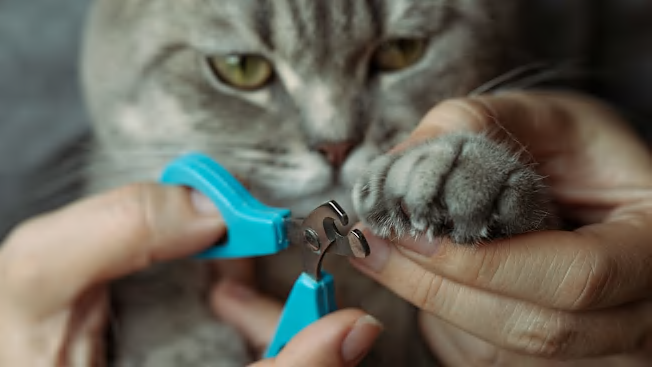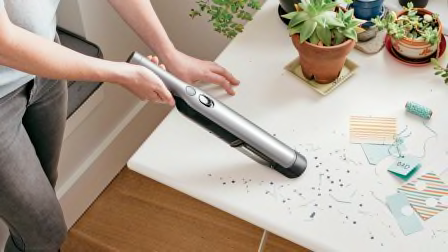Expert Tips for Clipping Your Cat’s Claws
Can’t get your cat to sit still for a nail trim? Veterinarians and cat-grooming pros share why claw care matters—and how to do it without the stress. Plus, are cat nail caps safe?
When you shop through retailer links on our site, we may earn affiliate commissions. 100% of the fees we collect are used to support our nonprofit mission. Learn more.

When Frank, a newly adopted house cat, went six months without a nail trim, his owner began to notice the consequences—snagged furniture, scratched arms, and a very frustrated feline. The price of a professional trim, around $30 a visit, made frequent grooming impractical, so she turned to at-home care.
If this sounds familiar, you’re not alone. As more cat owners embrace DIY grooming, nail trimming is often one of the most daunting tasks. But according to cat pros, it’s not only possible to master the skill—it’s essential for your cat’s health and well-being.
Why Trimming Your Cat’s Claws Matters
Cat claws grow continuously, and while outdoor cats tend to wear them down naturally, indoor cats often need help keeping them in check. Left untrimmed, nails can grow too long, curl under, and even puncture paw pads, leading to pain and infection.
Why Some Cats Resist Nail Trims
If your cat runs at the sight of clippers, you’re not alone. Many cats associate nail trims with fear or past trauma. Groomer Bri Harris, owner of Rustic Retreat Pet Spa, says owners often make common mistakes that set their pets up for stress, such as using the wrong tools, holding the cat improperly, or showing too much emotion.
“Cats don’t have a lot of patience,” Harris says. “If you make this as nonchalant as possible, they will respond to it better and see it as a way of life as opposed to punishment.”
We tested Tangle Teezer cat and dog brushes, too.
Kendra Martinez, a certified feline master groomer through the National Cat Groomers Institute and owner of Fluffin’ It Feline Grooming, adds that sudden movements and forceful restraint can backfire. “Grabbing the feet quickly or cornering the cat makes them defensive and more likely to lash out,” she says. “It’s best to build up to it slowly, like holding their paws during cuddle time.”
How to Trim a Cat’s Claws Without a Meltdown
Both Harris and Martinez agree: Preparation is key.
Start by getting your cat used to having their paws handled. Over time, gently press the pads to extend the claws and observe their reaction. Martinez suggests the “burrito wrap” technique—gently swaddling your cat in a towel to limit movement and prevent scratching. Martinez adds that using a domed E-collar and working quickly on a flat surface, such as a table, can help keep both you and the cat safe, just as vet techs do during nail trims.
When trimming, always use cat-specific scissor-style nail clippers. “Hold the paw, press the pad to extend the claws, and trim only the sharp tips,” says Martinez. “Avoid the pink area, or ‘quick,’ to prevent pain and bleeding.” Martinez recommends sharp, precision clippers like the Necoichi Purrcision clippers, noting that they cut cleanly without splitting the nail and are more comfortable for the cat. (CR has not tested these clippers.)
Harris recommends trimming in a confined space like a bathroom, with everything you need within reach. “Use your non-dominant hand to lift the paw and press the pad to expose the claws. Then trim with your dominant hand. Less is more--only trim what you can easily see for the front paws and take off the tip for the back paws,” she says.
If your cat shows signs of stress, such as panting, growling, or licking your hand, it’s best to stop and try again later.
While your cat may not seem grateful in the moment, a proper trim can improve their quality of life. Alleyne recommends regular trims, especially for older cats, to enhance mobility.
Are Cat Nail Caps a Safe Alternative?
For cat owners concerned about scratching, soft claw caps like Soft Claws can offer a short-term solution. These vinyl coverings are glued onto trimmed nails and prevent damage to furniture and skin.
Alleyne says that these products can help blunt the tips of their nails. “They help blunt the tips and can minimize scratching issues,” he says.
However, Martinez cautions that claw caps are not an alternative for trims. She says, “to apply them, it still requires the nail to be cut so the tip isn’t sharp, and they must be removed and replaced every 4 to 6 weeks as the nails grow out.” Martinez says that cats claw items because their nails grow in layers and shed. “Since the claw covers inhibit the natural shedding and sharpening of the nails, the nails are prone to growing into the pad of the paws, so the caps must be removed and replaced,” she says.
Why Declawing Is Not the Answer
Alleyne recommends careful consideration before opting for declawing as a permanent solution. “Declawing is an amputation of the third bone of the phalanges or fingers of a cat,” explains Alleyne. “It’s not a minor procedure—it can lead to chronic pain, behavioral issues, and long-term mobility problems.” Some states and countries have banned declawing. Instead, experts recommend regular nail trims, scratching posts, and positive reinforcement to manage destructive scratching behavior.
When to Call in a Professional
If your cat becomes aggressive or you’re not confident handling them, it’s okay to call a pro. Professional groomers are trained to handle difficult cats safely and efficiently.
"If a cat becomes aggressive during nail trimming, a veterinarian may need to be consulted to provide medications or to consider sedation. Also if there are obvious issues with the nails, then a veterinarian should be involved before the nails are trimmed,” Alleyne advises. For extremely aggressive cats, sedation or calming medications like Gabapentin may be prescribed.
With the right approach, regular at-home trims are both manageable and beneficial. Harris notes that it’s easier to train a cat than a dog when it comes to grooming. She suggests starting young, being consistent, and making it part of their routine for best results.
Final Tips for Success
• Trim every 2–4 weeks.
• Use cat-specific scissor clippers.
• Avoid the quick (pink area).
• Don’t rush—stop if your cat shows signs of stress.
• Use treats or licky snacks for positive reinforcement.
• Consult a groomer or vet if you’re unsure or if your cat is aggressive.
By building trust and creating a calm environment, even the most reluctant feline can learn to tolerate a quick, painless nail trim. Your furniture—and your arms—will thank you.




















